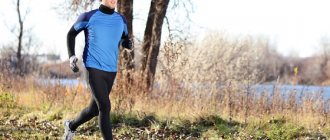At what temperature can you run?
You can run at any temperature. But I don’t recommend running when it’s below 20 degrees outside. The fact is that at such a low temperature you can simply burn your lungs while running. And if the running speed is low , then the body will not be able to warm up to such an extent that it is able to resist severe frost, and the likelihood of getting sick will be very high.
At the same time, you can run at lower temperatures . Everything will depend on humidity and wind. So, with high humidity and strong wind, minus 10 degrees will be felt much more strongly than minus 25 without wind and with low humidity.
For example, the Volga region is famous for its strong winds and humidity. Therefore, any frost, even mild frost, is very difficult to bear in these places. At the same time, in dry Siberia, even at minus 40, people calmly go to work and school, although in the central part, with such frost, all educational institutions and many manufacturing enterprises are closed.
Conclusion: you can run in any frost. Feel free to jog until minus 20 degrees. If the air temperature is below 20 degrees, then look at the humidity and presence of wind.
Positive effects on the body
Outdoor activities are beneficial at any time of the year.
During running, the following changes occur in the body:
- the musculoskeletal system is strengthened;
- the blood circulation process is activated, due to which each cell is better saturated with oxygen;
- the functioning of the cardiovascular system improves;
- Harmful compounds leave the body along with sweat;
- metabolism improves;
- the level of “bad” cholesterol in the blood decreases;
- body weight decreases;
- endurance and performance increase;
- the psycho-emotional background is normalized;
- brain function improves;
- insomnia disappears;
- the body's defenses are strengthened;
- Potency increases in men.
As for running outside in winter, its additional benefits include the following:
- The body becomes much more resistant to colds, which is due to its gradual adaptation to cold air.
- Due to the absence of the need to interrupt training for a long period of time, it becomes possible to stay in shape all year round.
- The body is hardened in a natural way, which improves the functioning of most systems.
- After a run, you remain energetic and feel good for a long time, which is explained by the presence of air ions in the frosty air.
Despite the impressive list of positive properties, you need to carefully prepare for training in the cold season. The benefits and harms of running outside in winter are determined by compliance with this particular condition.
How to dress for running in winter
Choosing clothes for running in winter is a very important issue. If you dress too warmly, you may sweat at the beginning of your run. And then it starts to cool down, which can cause hypothermia. Conversely, if you dress too lightly, then your body will not have the strength to produce the required amount of heat, and you will simply freeze.
There are a number of basic points you need to know when choosing running clothes:
1. Always wear a hat when running in winter, regardless of the frost. A hot head that begins to cool down while running means you are more likely to get at least a cold. The hat will keep your head cool.
In addition, the hat must cover the ears. Ears are a very vulnerable part of the body when running. Especially if the wind is blowing. It is advisable that in cold weather the hat also covers the earlobes.
It is better to buy a tight-fitting hat without various pom-poms that will get in the way while running. Choose the thickness of the hat depending on the weather. It is better to have two hats - one for mild frosts - a single-layer thin one, and the second for severe frosts - a dense two-layer one.
It is better to choose a hat from synthetic fabrics rather than wool, since a woolen hat is easy to blow through and, moreover, it absorbs water, but does not push it out so that the head does not get wet. Synthetics, on the contrary, have the property of pushing water out. That's why runners' hats are covered with frost in winter.
2. You should only run in sneakers. At the same time, you don’t need to buy special winter sneakers with fur inside. Your feet won't get cold when running. But try to buy sneakers that do not have a mesh surface. Snow falls through this surface and melts on the foot. It is better to buy solid sneakers. At the same time, try to choose shoes so that the sole is covered with a layer of soft rubber, which slips less on the snow.
3. Wear 2 pairs of socks when jogging. One pair will absorb moisture, and the other will retain heat. If possible, purchase special two-layer thermal socks that will perform the function of 2 pairs. In these socks, one layer collects moisture, and the second retains heat. You can run in just socks, but not in severe frost.
Don't wear wool socks. It will have the same effect as with a hat. In general, you shouldn’t wear anything wool when going for a run.
4. Always wear underpants. They act as a sweat collector. If possible, purchase thermal underwear. The cheapest options don't cost much more than a hat.
5. Wear sweatpants over your underpants, which will keep you warm and protect from the wind. If the frost is not severe, and the thermal underwear is two-layer, then you don’t have to wear pants if there is no wind.
6. The same principle applies to choosing clothes for the torso. That is, you need to wear 2 T-shirts. The first collects sweat, the second retains heat. On top you need to wear a thin jacket, which will also serve as a heat insulator, since a T-shirt alone will not cope with this. Instead of 2 T-shirts and a sweater, you can wear special thermal underwear, which alone will perform the same functions. In severe frost, even if you have thermal underwear, you should wear an extra jacket.
On top you need to wear a sports jacket that will protect from the wind.
7. Be sure to make sure your neck is covered. To do this, you can use a scarf, balaclava or any jacket with a long collar. You can also use the collar separately.
If the frost is severe, then you should wear a scarf, which can cover your mouth if necessary. The mouth should not be closed too tightly; there should be a centimeter of free space between the scarf and lips. To make it easier to breathe.
8. If your hands are cold, wear gloves while jogging. In light frost, you can wear only gloves. During severe frosts, either one is denser, or two are thin. Gloves must be purchased from synthetic fabrics. Woolen ones won't work. Because they will allow the wind to pass through.
On the one hand, it may seem like there are too many clothes. In fact, if it is comfortable, then there will be no problems while running either.
Shoes
Only sneakers are suitable for this type of training. For running outside in winter, you need to purchase ones that are designed specifically for this. Such products do not have a mesh base and are equipped with a soft rubber sole.
Thus, shoes for running outdoors in winter perform several tasks at once:
- does not get wet;
- keeps warm;
- Provides good grip on snow-covered surfaces.
There is one caveat - running shoes for winter are not suitable for activities at other times of the year. This is due to the fact that their soles wear out very quickly when interacting with asphalt.
How to breathe when running in winter
It is necessary to breathe in winter, contrary to public opinion, both through the mouth and nose. Of course, nasal breathing better warms the air that enters the lungs. But if you run at your own pace, your body will be well warmed up and the air will still be warm. From the experience of many runners, I can say that they all breathe through their mouths, and no one gets sick from it. And if you breathe exclusively through your nose, you won’t be able to run at your own pace for long. Since the body will not receive the required amount of oxygen.
However, when the temperature is below 10 degrees, you should not open your mouth too much. The best way is to wrap the scarf so that it covers your mouth. At temperatures below minus 15 degrees, you can cover both your nose and mouth with a scarf.
This, of course, will make breathing more difficult, but the likelihood that you will take in cold air will be minimal.
Warm-up
Many novice athletes neglect the preparatory stage, which is a serious mistake. A good warm-up prepares the body for the upcoming loads. If you run outside in winter to lose weight, it “programs” it for an active process of burning calories.
In the warm season, not much time is devoted to warm-up, but in winter it should take at least 2 times longer. This is necessary for uniform warming of all muscle groups. There is no special set of exercises before winter jogging; they are standard and must include stretching. It is important for preparing ligaments and muscles for serious loads.
A good warm-up with an emphasis on stretching significantly reduces the risk of various injuries.
Other features of running in winter
Never drink cold water while jogging in cold weather. When you run, you are saved by the fact that no matter how cold it is outside, it is always hot inside. If you let the cold in, then your body will most likely not be able to cope with it and you will get sick.
Monitor your own feelings. If you begin to realize that you are gradually getting cold, your sweat is cooling, and you are unable to increase your pace, then it is better to run home. A slight feeling of coolness can only be felt at the beginning of the cross. After just 5-10 minutes of running you should be warm. Otherwise, it will indicate that you are dressed too poorly.
Don't be afraid to run in the snow. But it’s difficult to run during a snowstorm, and I would recommend that you sit out this weather at home.
To improve your performance in middle and long distance running, you need to know the basics of running, such as proper breathing, technique, warming up, knowing how to do the right run for race day, doing the right strength work for running, and others. Therefore, I recommend that you familiarize yourself with unique video lessons on these and other topics from the author of the site scfoton.ru, which you are currently on. For site readers, video tutorials are completely free. To receive them, just subscribe to the newsletter, and in a few seconds you will receive the first lesson in the series about the basics of proper breathing while running. Subscribe here: Running Video Tutorials . These lessons have already helped thousands of people, and they will help you too.
0
Author of the publication
offline for 2 weeks
Contraindications
Before you start exercising, you need to make sure that you are in excellent health. Even a slight runny nose is a contraindication to running outside in winter, since one breath of cold air is enough to make the situation worse. In addition, it is not advisable for those who have incompletely healed lower extremity injuries to go to training.
Not only during the cold season, but at any time of the year, it is necessary to consult a doctor for people suffering from thrombophlebitis, serious pathologies of the cardiovascular system and the musculoskeletal system. After the examination, the specialist will be able to correlate the benefits and harms of running outside in winter for the patient. You can start training after his permission.











